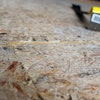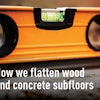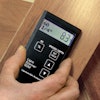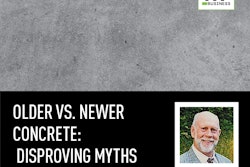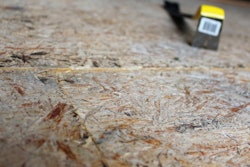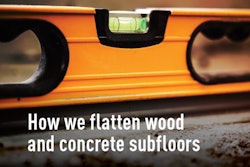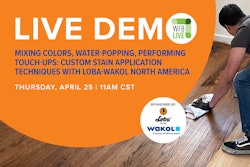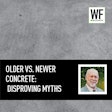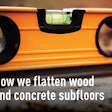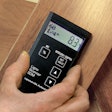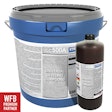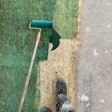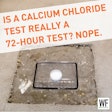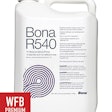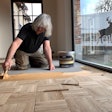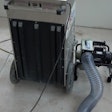
It can be hard to imagine that a thin layer of paper or plastic may be the difference between a successful wood flooring installation and a complete failure, but underlayments may be the miniinsurance policy a contractor needs. Technically, anything underneath hardwood flooring qualifies as an underlayment. This includes substrates such as plywood and OSB, as well as self-leveling compounds. For this article, because many contractors are in the dark about them, the main focus will be moisture- or vapor-retarder (formerly referred to as vapor-barrier) and sound-reduction underlayments.
There are several important things to remember about underlayments from the start. First, always defer to the manufacturer's instructions. If a hardwood flooring manufacturer requires a certain vaporretarder or sound reducer for its product, use it. If an underlayment manufacturer says its product can't be used in certain applications, find something more suitable for your job. Also, make sure you evaluate the job site. Is there a moisture problem? Is sound control an issue? Most importantly, know your product. Always read and follow the wood flooring manufacturer's recommendations and, if necessary, talk with the manufacturer and your distributor to make sure the product is applicable in your situation.

Wet 'n' Wild
The majority of calls to the NWFA technical hotline, as well as most inspections, are moisture-related. Moisture itself isn't necessarily a problem; it's how you handle (or don't handle) the moisture levels that causes problems. Installation of a vapor retarder reduces the potential for moisture or moisturerelated problems, but does not guarantee to eliminate them.
NWFA guidelines define an acceptable vapor-retarder for wood subfloors as a vapor-resistant material, membrane or covering with a vapor permeance (or perm rating) between 0.7 and 50. Moisture vapor permeance is the rate at which moisture travels through a substance, in this case, from the subfloor into the flooring (a higher number indicates less resistance to moisture). The purpose of a vapor-retarder is to slow the rate of moisture movement to the hardwood to protect the flooring and reduce or prevent cupping or other moisture-related problems. Moisture-retarders tend to fall into three general categories:
Permeable: These provide a perm rating of 3 and higher. Permeable vapor retarders allow moisture to pass through, and are generally installed over wood subfloors. Permeable membranes slow seasonal changes in moisture vapor movement enough to give hardwood flooring over wood subfloors some protection. These products include Type I asphalt-saturated felt paper (also called #15 or #30 felt) and asphalt-saturated Grade D kraft paper. Be sure to use products that meet industry standards: ASTM D4869 and UU-B790a Grade D. Asphalt-saturated products typically come in rolls and are installed over the subfloor with the seams overlapping a minimum of 4 inches. Some experts say asphalt-saturated felt does little to protect wood flooring from moisture since its perm rating is more than 4. However, many contractors still use asphalt-saturated felt paper in order to keep a concrete subfloor from deteriorating their 6-mil polyethylene vapor-retarder or just to provide a smooth surface on which to work. A system for using felt over a concrete subfloor is the "two-layer felt system," which sandwiches asphalt mastic/felt/mastic/felt/ mastic, with the plywood and flooring nailed over it. But overall, asphalt-saturated kraft paper may be a better bet since its perm rating is lower (almost down to 0.8 in some cases).
Semi-permeable: These have a perm rating of 0.7 to 2.9, so they allow some moisture vapor to travel through, but more slowly than with a permeable membrane or no membrane at all, giving hardwood flooring more protection. These products include asphalt-laminated paper and some asphalt-saturated kraft papers, and usually are used over a wood subfloor. They come in rolls, and seams are overlapped a minimum of 4 inches. Be sure the product you choose meets ASTM UU-B-790a Grade B.
Impermeable: These have a perm rating of 0.15 or less, bringing moisture migration from the subfloor very close to zero, and are acceptable over concrete. The most common impermeable underlayment is construction-grade 6-mil polyethylene film. It is rolled out over a concrete slab with the seams overlapping 12 inches. The seams should be taped when installing an impermeable moisture retarder.
An emerging class of impermeable vapor retarders are the liquid-applied chemical underlayments, which include trowelable or rollable barriers (some may have a perm rating higher than 0.15). They are typically available in single-component urethane or two-component epoxy and are recommended for concrete slabs on or below grade. The urethane is troweled on, while the epoxy is applied with a paint roller. Adhesives bond well to these urethane or epoxy products, and since they have moisture-retarder qualities, they can be used in lieu of 6-mil polyethylene, which can't be used under adhesives.
RELATED: Step by Step: How to Get a Concrete Slab Ready for Wood Floors
Vapor Retarder Dos and Don'ts
Don't assume you won't have moisture problems since your current readings say the job site is dry enough.
Do use a vapor retarder.
Don't install an impermeable moisture barrier over a wood subfloor. This could trap moisture in the subfloor, possibly causing rot and leading to health and structural problems.
Do use impermeable barriers on concrete slabs for below- and on-grade applications, and over crawlspaces. Use only permeable or semi-permeable retarders on wooden subfloors.
Don't nail through an impermeable moisture retarder. This reduces the effectiveness of the retarder and allows moisture to travel through freely.
Do float two layers of plywood stapled to each other over the vapor retarder and nail flooring to that, or glue or float flooring directly over trowelable underlayment.
Don't use red rosin, building paper or unsaturated kraft paper as moisture retarders over wood subfloors. The permeability is too high to offer any protection to wood flooring.
Do find a retarder with a permeability rating and written recommendation by the manufacturer for your particular subfloor.
Don't forgo moisture underlayments with radiant heating.
Do follow the manufacturers' recommendations regarding vapor retarders for radiant heat and, when required, use a non-asphalt underlayment (asphalt may cause an odor when the radiant heat is first turned on).
Slab Work
As with every job, test the moisture content of your subfloor and your hardwood flooring (for more information, see "Measuring Moisture" in the October/November 2006 issue of Hardwood Floors and "Concrete Facts" in August/September 2007). Slabs testing higher than 3 pounds of moisture should have a 6-mil polyethylene film or a concrete sealer, often found in the new rollable or trowelable moisture retarder products, installed over them. These products should be warranted by the manufacturer for the level of moisture emissions the slab is giving off. Even if testing indicates an acceptable slab, moisture conditions may change in the future and you may want to consider a vaporretarder as a further precaution. The NWFA suggests automatically using a vapor retarder when solid ¾-inch hardwood is installed over a concrete slab. Other than these guidelines, a contractor has a lot to choose from, and a lot of opportunity to make mistakes.
Sound Abatement
As high-rise and multifamily dwellings become more commonplace, there is a need to reduce sound from the neighbors. For these projects, architects or builders typically have a number in the building specifications that they want flooring contractors to reach for noise protection. These regulations, typically issued by the Uniform Building Code or the International Building Code, specify STC or IIC numbers. Sound Transmission Class (STC) quantifies the transmission of airborne sound (the neighbor playing his stereo) through building elements such as walls, windows, doors or flooring systems. Impact Isolation Class (IIC) measures impact sound (the neighbor tap-dancing on the floor) through a floor/ceiling assembly system. Manufacturers authorize the testing for their products and then provide the results of STC and IIC testing for their underlayments in specific and detailed floor/ceiling assemblies.
The higher test rating a product receives, the better it is at sound reduction. Building specifications typically require a minimum 50 IIC and 50 STC value.
This is where things get tricky for flooring contractors: An underlayment might be tested in a controlled setting with an 8-inch concrete slab, a 12-inch space and an acoustic-absorbing ceiling below it, which would provide better results than will be experienced on the actual job site. Typical buildings aren't built this way and testing results will likely be at least two to three points higher than they will be on the job site. For jobs where there isn't a specific sound reduction product specified, unless a wood flooring contractor has extensive experience with sound reduction, it's best to consult with an expert to determine what product will perform to expectations
RELATED: Understanding How to Measure Moisture Can Avert Job-Site Disasters
Sound control products commonly come in two types: synthetic and cork.
Synthetic: Most commonly in foam or other artificial materials, it is available in either open-cell, closed-cell or needle-punch construction. Closed-cell is often more expensive, but it can prevent the flattening out seen in some open-cell foams, making it more effective for sound control. Needle-punch construction mechanically interlocks synthetic or natural fibers, using no bonding agent such as glue.
Synthetic underlayments can be used over wood or cement subfloors and are used primarily under floating floors. Synthetic products come in rolls and are laid out with butt ends at the seams. Some manufacturers recommend taping the seams in order to prevent sound from traveling through the cracks, or some provide overlap strips with pull-off tape. For full sound abatement, the underlayment needs to run up the wall 6 inches. It may present a problem for direct glue-down installations, as some adhesives don't adhere well to PVC.
Cork: It is typically called ¼-inch cork, but it is actually 6 mil. It is often glued to concrete in a high-rise with engineered flooring glued over it, and can also be used for floating or solid flooring. Cork underlayment is available in either rolls or sheets, and, like foam, is installed with butt ends at the edges in a tight fit, with seams taped to prevent sound migration. High-quality cork underlayments retain a high percentage of their original shape, even after years of foot traffic, and cork is often used as a green alternative to foam. However, it is more expensive and requires additional labor. Also, if used on a concrete slab protected by 6-mil polyethylene, the adhesive won't be able to glue cork to the polyethylene, so consider using a "buffer" layer of asphalt-saturated kraft paper or similar product.
Sound Abatement Dos and Don'ts
Don't choose an inexpensive underlayment for floating flooring that will flatten out, as this may damage "click-lock" joints and also reduce sound effectiveness.
Do choose higher-quality underlayments that will retain shape and prevent flooring movement.
Don't nail through or in other ways puncture the sound underlayment. This will negate its effectiveness.
Do float plywood or the flooring over the underlayment so flooring can be fastened down without damaging the underlayment.
Don't just lay the underlayment down and expect it to do its job.
Do remember to tape the seams of the underlayment to prevent sound from traveling through it.
Don't remedy flooring noises by simply drilling screws through the flooring into the subfloor, which typically punctures the sound barrier.
Do make sure the subfloor is flat so undulations won't cause noises in the flooring.
Two for One
At first, it may seem moisture retarders and sound reducers are mutually exclusive: Moisture problems are more likely to occur on or below grade, where sound abatement isn't usually necessary, and on jobs where sound abatement is required, there is little chance of a moisture problem over what is typically an air-conditioned, environmentally controlled space. However, when dealing with concrete slabs, especially for a project under serious time constraints, the flooring may be installed before the slab has acceptable moisture levels. Or, conditions may change due to flooding or other environmental impacts. There are products that combine both sound reduction and moisture protection. At least one trowelable product has both vapor reduction and sound prevention qualities mixed in, and many varieties of foam feature a moisture barrier film.
Final Cut
Some contractors are always looking for shortcuts or a formula to dictate which products they should use but, as with many things in life, there really aren't any quick answers. Understand your wood flooring and the job-site conditions, determine what your concerns are about that particular job, and go from there to gather information about which moisture retarder and/or sound abatement options will work best to protect your floor and help your clients live in peace.
Sources for this article included: Roger Barker, Fortifiber Building Systems Group; Alan Blake, Rob Woodley and David Gladden, GAF-ELK Corp.; Lenny Hall, Endurance Floor Co. Inc.; Frank Kroupa, NWFA; Larry Lyons, Amorim Industrial Solutions; Phil Pitts, Bostik Inc.; Lanny Trottman, Global Market Partners Inc.; and Danielle Watier, Finitec Canada.












